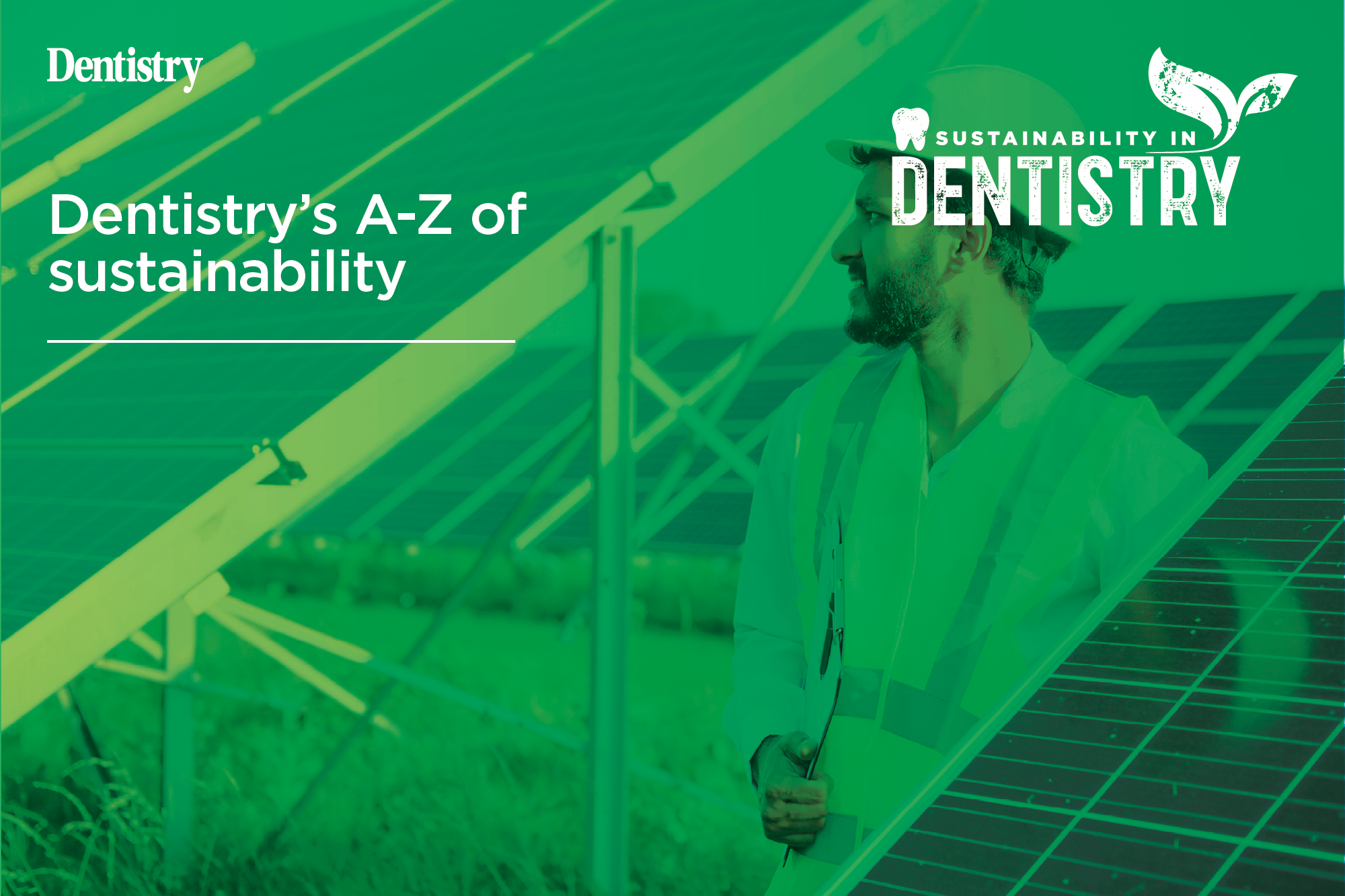
Dentistry
Dentistry deals with the oral health, encompassing the diagnosis, prevention, and treatment of oral diseases and conditions.
Dentistry deals with the oral health, encompassing the diagnosis, prevention, and treatment of... View more
Introducing Dentistry’s A-Z of sustainability
-
Introducing Dentistry’s A-Z of sustainability

Are you confused by green jargon? Dentistry‘s guide to all of the commonly used terms around sustainability is here to help.
B Corp
B Corporations, commonly known as B Corps, are businesses certified to have met various standards relating to sustainability, society, transparency and accountability. They are accredited by B Labs and operate in 96 countries. There are currently more than 8,000 B Corps around the world.
Biodegradable
Biodegradable materials can be broken down by natural processes into harmless products. For example, wood, bamboo, food waste and paper.
Carbon dioxide
Carbon dioxide is an important greenhouse gas, which is released when burning fossil fuels and during other human activities. Like other greenhouse gases, it absorbs and radiates heat in all directions, meaning some will return to earth and contribute to global warming. Carbon dioxide’s concentration in the atmosphere was 421 parts per million (ppm) in May 2022, up from 365ppm in 2002 and 280ppm before the industrial revolution (mid-18th century). CO2 makes up around 74% of greenhouse gas.
Carbon dioxide equivalent
Often abbreviated to CO2, carbon dioxide equivalent is a means of measuring the impact of other greenhouse gases on the climate. For example, one tonne of methane will have the same global warming potential as around 30 tonnes of carbon dioxide. These factors are taken into consideration when measuring carbon footprints.
Carbon footprint
This measurement calculates the climate-damaging emissions released by, for example, individuals, activities, businesses and countries. The footprint is calculated in terms of the carbon dioxide and carbon dioxide equivalents released into the atmosphere.
Carbon neutral
Carbon neutrality is when carbon dioxide emissions are offset by actions that remove carbon dioxide from elsewhere in the atmosphere, for example by planting trees. This is different from net zero, which requires a significant reduction in carbon dioxide and other greenhouse gases, with a lesser role for carbon offset schemes.
Carbon offset
Carbon offset is a system by which businesses, individuals and institutions can offset their carbon emissions through schemes such as tree-planting, which capture carbon dioxide from the atmosphere. This is often done through buying carbon credits, with each credit offsetting a tonne of carbon dioxide.
Climate positive
This means removing more carbon dioxide and other greenhouse gases from the atmosphere than you put in, and therefore having a net positive impact on cutting emissions.
Compostable
Any form of waste that will biodegrade into harmless products in compost.
Corporate social responsibility
Corporate social responsibility (CSR) is the term given to businesses integrating social and environmental concerns into their operations.
Cradle to grave
This is a way of assessing the environmental impact of a product through its entire lifecycle. This includes things like emissions released during the extraction of the raw materials used to manufacture it, through to those associated with its use and eventual disposal.
Decarbonisation
Decarbonisation is the process of reducing the amount of carbon dioxide released into the atmosphere, for example by using more renewable energy and less deriving from fossil fuels.
Fossil fuels
Fossil fuels, such as oil, coal and natural gas, are formed from the remains of plants and animals in the earth’s crust over millions of years. They contain hydrocarbon, allowing them to be burned and used as an energy source. They are the leading cause of climate change, as their combustion releases carbon dioxide and other greenhouse gases into the atmosphere. Around 70% of greenhouse gas released into the atmosphere through human activity is carbon dioxide released during the use of fossil fuels.
Greenhouse gases (GHGs)
GHGs are gases that absorb and then radiate heat. The sun warms the planet, which then radiates heat into the atmosphere. GHGs absorb this heat, creating a warmer climate. The most abundant GHG is carbon dioxide (around 75%), followed by methane (16%) and nitrous oxide (around 6%). Greenhouse gases have different levels of potency and duration in the atmosphere. For example, a tonne of methane can trap far more heat than a tonne of carbon, but while methane stays in the atmosphere for around a decade, carbon dioxide can remain there for thousands of years.
Global warming
Global warming refers to the increasing temperature of the climate as a result of natural or human activities.
Greenhouse effect
The greenhouse effect refers to the process of global heating that results from heat being trapped in the atmosphere by greenhouse gases (GHGs), such as carbon dioxide, methane and nitrous oxide. GHGs absorb heat from the sun radiated back up from the earth. While the current concern is over a greenhouse effect caused by human activity, it is also a naturally occurring phenomenon, caused in our own planet’s history by things like volcanos and meteor strikes.
Greenwashing
Greenwashing refers to attempts to promote environmental credentials in a misleading way. For example, a highly polluting manufacturer might want to publicise a limited tree-planting project as an example of its green ethos, despite its otherwise poor environmental record.
ISO 14001
ISO 14001 is the internationally recognised standard for designing and implementing environment management systems (EMS). These help businesses and other organisations reduce their carbon footprint through changes in behaviour.
Microplastics
Microplastics are fragments of plastic of less than 5mm. They are most frequently the result of breakdown of larger pieces of plastic, for example discarded toothbrushes or car tyres, but they are also created intentionally, such as for use in body scrubs. Microplastics can affect the health of humans and animals as they can damage cells, cause respiratory diseases and carry pathogenic microbes and other harmful substances, like heavy metals. They are now found in everything from food to drinking water and, as a result, our own bodies. It is difficult to avoid exposure to microplastics, but limiting use of plastics where possible can at least limit their impact.
Net zero
Net zero is the concept of dramatically reducing greenhouse gas emissions while offsetting those that remain.
Organic
In the context of sustainability, organic refers to food, drink and materials based on certain ecological principles. The term most commonly refers to agricultural methods that avoid things like the use of harmful synthetic fertilisers and pesticides and promote healthier soils, which also act as carbon sinks. According to the Soil Association, if all farmland in Europe followed organic principles, agricultural emissions would be halved by 2050.
Renewable energy
Renewable energy comes from a sustainable source, such as the sun, wind and the movement of water. It stands in contrast to non-renewable energy sources such as fossil fuels, which release carbon dioxide and other greenhouse gases.
Scope 1, 2 and 3 emissions
Firstly, scope 1 emissions are those coming directly from a business, including things like fuel combustion in company vehicles. Scope 2 emissions are those coming from the energy purchased by your business, including electricity and gas. Scope 3 covers everything else – from business travel to the impact of waste produced.
Sustainability
Put simply, sustainability is a way to use the world’s resources in a way that could continue indefinitely, without using them all up or causing environmental or social harm. For example, using solar energy is sustainable because there is in effect an infinite supply of it, and there are no harmful emissions associated with its use. Burning coal for energy, in contrast, is unsustainable because supplies can run out and its combustion releases greenhouse gases. Sustainability generally refers to operating in a way that minimises environmental and social harm.
Triple bottom line
Profits are generally considered to be the bottom line for businesses, but the triple bottom line also considers social and sustainability factors.
Follow Dentistry.co.uk on Instagram to keep up with all the latest dental news and trends.
Sorry, there were no replies found.
Log in to reply.
